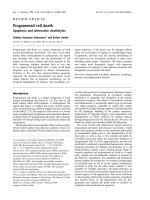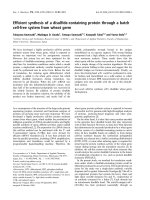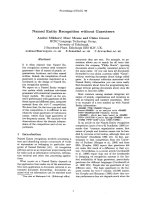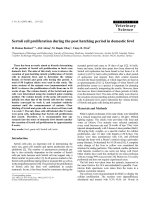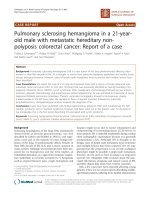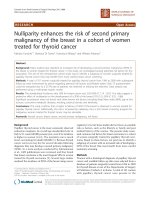Báo cáo khoa học: "Renal cell cancer without a renal primary" pptx
Bạn đang xem bản rút gọn của tài liệu. Xem và tải ngay bản đầy đủ của tài liệu tại đây (209.14 KB, 3 trang )
CAS E REP O R T Open Access
Renal cell cancer without a renal primary
M Wayne
*
, W Wang, J Bratcher, B Cumani, F Kasmin, A Cooperman
Abstract
Renal cell carcinoma has been increasing in incidence over the past two decades. Men are affected more than
women and metastatic disease at presentation occurs in up to one third of patients. Metastasis can occur to vir-
tually any organ, and involvement of multiple organs is not uncommon. To date, no reports have been found of
metastatic disease without a renal primary. We present a case of renal cell cancer initially presenting as a subcuta-
neous mass with subsequent pancreatic and parotid gland metastases in absence of a primary renal source.
Background
In the United States, renal cell carcinoma (RCC) h as
incidence in excess of 30,000 cases, with 12,000 deaths
every year from the disease [1]. It occurs predominantly
in males in their sixth to eight decade of life, and Afri-
can Americans have a 10-20% higher incidence [2]. RCC
is well known for its ability to metastasize to nearly
every organ system of the body. Metastasis usually
occurs several years after identification o f the renal pri-
mary, but up to 30% of patients have metastatic disease
on initial presentation [3]. The most common targets
for metastases are lung, bon e, lymph nodes, adrenal
glands, brain, liver, and contralateral kidney [4]. In con-
trast, pancreatic and cutaneous involvement is exceed-
ingly rare, occurring approximately 0.25-3% and 3.3% of
the time, respectively [5]. Metastatic RCC is typically
classified as either synchronous (detected at the same
time as primary tumors) or metachronous (detected
after a tim e interval from primary tumor, normally >6
months). In fact, it is not unc ommon for metastatic
pancreatic lesions to develop several years after
nephrectomy [6]. RCC with pancreatic involvement can
be a diagnostic challenge in differentiating between pri-
mary pancreatic cancer and metastatic disease. Our case
exemplifies this diagnostic difficulty as the patient devel-
oped subcutaneous, pancreatic and parotid gland meta-
static foci of RCC without ever having developed
evidence of a renal primary.
Case presentation
In October, 2007 a 61-year-old woman presented to
Saint Vincent’ s Medical Center with a 5 cm subcuta-
neous growth on her left upper extremity. Histological
examination after surgical excision of the mass revealed
a clear cell neoplasm c onsisting of polygonal cells with
abundant clear cytoplasm, containing faint granular
material. Immunohistochemical analysis demonstrated
positive CD10 and AE1/AE3 staining. Pathologic int er-
pretation of the mass was highly suggestive of metastatic
RCC of the clear cell type. There were no lesions pre-
sent anywhere else by physical examination or CT scan.
The patient was closely followed in an attempt to
locate a primary renal source of disease with multiple
imaging studies negative for a renal primary or other
sites of metastasis. However, repeat CT scan 9 months
later revealed an asymptomatic pancreatic mass. Endo-
scopic evaluati on was performed with endos copic ultra-
sound and fine needle aspiration (EUS/FNA). The study
demonstrated a 2-cm hyperechoic, well-defined lesion in
the body of the pancreas. The remaining pancreatic par-
enchyma was otherwise normal without ductal dilation
or evidence of pancreatitis. Histomorphological analysis
of the core biopsy samples yielded similar findings to
those of the upper extremity mass. Additionally, an
immuno-profile was focally strong for both CD10 and
PNRA, which was again highly suggestive of renal cell
carcinoma. A central pancreatectomy was performed in
August 2008 and tissue samples were positive for
PRNA, Vimentin, and CD10, correlating strongly with
RCC. The patient continued periodic surveillance to
identify a renal primary and further metastasis at three
month intervals. Six months later, physical exam
revealed left parotid gland en largement and an MRI
* Correspondence:
Pancreatic and Biliary Center N.Y, 170 W12th St., Cronin Bldg, NY, NY 10011,
USA
Wayne et al . World Journal of Surgical Oncology 2010, 8:18
/>WORLD JOURNAL OF
SURGICAL ONCOLOGY
© 2010 Wayne et al; licensee BioMed Central Ltd. This is an Open Access article distri buted under th e terms of the Creativ e Commons
Attribution License ( which permits unrestricted use, dis tribution, and reproduction in
any medium, provided the original work is properly cited.
revealed a 1.6 cm enhancing mass in the left parotid
gland. No other lesions were found on surveillance
PET/CT scan at that time. The patient had a superficial
parotidectomy and again, pathological analysis demon-
strated a clear cell carcinoma that was identical to the
previous subcutaneous and pancreatic specimens. The
sample was sent for expert verification at an outside
institution, which corroborated our findings. Currently,
the patient is doing well and is undergoing surveillance
at 6 month intervals. To date, a renal primary has not
been found.
Conclusions
RCC has an annual incidence in excess of 30,000 cases
in the U nited States and its greatest incidence occur s in
males during the sixth decade of life [7]. The nature of
this tumor distinguishes itself from other cancers in sev-
eral respects. Nam ely, it’s peculiar ability to metastasize
to nearly every region of the body several years after
initial presentation. It also differs from other neoplasm s
in its predilection for both hematogenous and lymphatic
spread. We present the first recorded case of three
metastatic foci without the identification of a renal pri-
mary, one of which mimicked a primary pancreatic neo -
plasm. As far as pancreatic cancers are concerned,
metastatic tumors comprise about 3% of pancreatic
tumors overall [7]. Initial clinical symptoms include
abdominal pain, weight loss, fatigue, anemia, diarrhea,
and jaundice. However, mass lesions often do not pro-
duce any recognizable symptoms and are only diagnosed
when found incidentally on radiographic imaging, as was
the case in our report. Furthermore, solitary pancreatic
metastasis from RCC can mimic primary pancreatic
neoplasms, including pancreatic neuroendocr ine tumors
(islet cell tumo r), solid pseudopapillary tumors, mixed
ductal-endocrine carcinomas, ductal adenocarcinomas
with clear cell features, perivascular epithelioid cell
tumors (sugar tumo r), or solid serous cystadenomas
[8,9]. Most notably RCC and clear cell primary tumors
of the pancreas may show considerable overlap in both
clinical setting and pathological appearance, making
complete distinction between the two tumors very diffi-
cult without additional studies. Morphologically, pan-
creatic ductal adenocarcinoma with clear cell features
are composed of pleomorphic cells with abundant clear
cytoplasm and well-defined cell borders. Nuclei are
moderately pleomorphic with irregular borders and
often eccentrically positioned. Chromatin varies from
vesicular to coarsely granular and nucleoli are not pro-
minent. Alternatively, nuclei of RCC tend to be round
and uniform, with finely granular, evenly distributed
chromatin. Depending upon the degree of differentia-
tion, nucleoli may be absent, sparse, large, or prominent.
Occasionally, there are very large nuclei lacking nucleoli
or bizarre nuclei [10]. The architectural growth patterns
of clear cell RCC can vary, ranging from sinusoidal and
sheet-like solid patterns to alveolar, tubular, or acinar
appearances. No luminal differentiation is apparent in
the alveolar pattern but a central, rounded luminal
space filled with lightly acidophilic s erous fluid or ery-
throcytes occurs in the acinar pattern. Infrequently,
clear cell RCC has a distinct tubular or tubulopapillary
architecture.
Immunohistochemical studies are helpful to d istin-
guish metastatic from pr imary pancreatic tumors.
According to the literature, 90-100% of pancreatic ade-
nocarcinomas express CK7 as well as CK8,13,18, and 19
[11-13]. Even though CK20 is found in less than 20% o f
pancreati c cancers, most studies report the CD7+/CK 20
+ as the most common and the CK7+/CK20- as the sec-
ond most common staining patterns [14], although the
reverse has also been reported [11]. The coor dinate
staining pattern CK7-/CK20+ was found in up to ten
percent of pancreatic ductal adenocarci nomas. Glyco-
protein tumor antigens CEA and CA19-9 are reported
to be positive in a variety of patients with pancreatic
adenocarcinoma. As for clear cell RCC, lack of both
CK7 and CK20 expression has been found [15-17],
although papillary and chromophobe RCC were
reported to have some CK7 expression [18-20]. CEA has
been reported to be negative in all metastatic clear cell
RCC to the pancreas [7]. Finally, vimentin staining is
normally positive in RCC, occurring in >90% of cases,
while it is non-reactive in more than 90% of pancreatic
adenocarcinomas [21].
For patients with solitary pancreatic metastases, surgi-
cal treatment should be recommended because it is
more effective than other treatments such as radiation
and chemotherapy. The mean survival reported in the
literature is only 1.3 years following metastatic focus
resection [7], but 5 year survival rates as high as 68%
have been documented [22].
In summary, this case describes the first documented
report of metastatic RCC without the determination of a
primary renal tumor. In the vast majority of cases, the
primary renal lesion is found through subsequent radio-
graphic surveillance, sometimes up to several years after
the discovery of the initial metastatic lesion, which did
not occur in our patient. The fact that this case presented
with evidence of metastasis to three different sites (the
subcutaneous tissue of the arm, the pancreas and the par-
otid gland) demonstrates the interesting ability of RCC to
invade almost any organ and also reinforces the need for
a thorough work-up to distinguish primary pancreatic
neoplasm from another metastatic process. Although
many cases are found incidentally from radiographic ima-
ging obtained for other reasons, tissue sampling for
pathological and immunohistochemical analysis is
Wayne et al . World Journal of Surgical Oncology 2010, 8:18
/>Page 2 of 3
essential to help determine the tumor origin. When
metastatic RCC is found, complete surgical resection
should be the treatment of choice when medically
feasible.
Consent
Informed Consent was obtained from the patient for the
publication of this case report.
Authors’ contributions
MW is the lead author and surgeon for this case. It is his patient being
written about.
WW is the lead pathologist, who did extensive research on this case. BC is
the resident doctor who performed the literature search. JB is the GI doctor
who aided in the review and correction of this article. FK is the GI doctor
who performed the procedure. AC is the senior surgeon who assisted in the
case and in the write up of the case.
Competing interests
The authors declare that they have no competing interests.
Received: 1 July 2009 Accepted: 22 March 2010
Published: 22 March 2010
References
1. Chow WH, Devesa SS: Contemporary epidemiology of renal cell cancer.
Cancer J 2008, 14(5):288-301.
2. Pascual D, Borque A: Epidemiology of kidney cancer. Adv Urol 2008,
782381.
3. Motzer RJ, Bander NH, Nanus DM: Renal-cell carcinoma. N Engl J Med 1996,
335(12):865-75.
4. Saitoh H, Hida M, Nakamura K, Shimbo T, Shiramizu T, Satoh T: Metastatic
processes and a potential indication of treatment for metastatic lesions
of renal adenocarcinoma. J Urol 1982, 128(5):916-8.
5. Ninan S, Jain PK, Paul A, Menon KV: Synchronous pancreatic metastases
from asymptomatic renal cell carcinoma. JOP 2005, 6(1):26-8.
6. Kassabian A, Stein J, Jabbour N, Parsa K, Skinner D, Parekh D, Cosenza C,
Selby R: Renal cell carcinoma metastatic to the pancreas: a single-
institution series and review of the literature. Urology 2000, 56(2):211-5.
7. Thompson LD, Heffess CS: Renal cell carcinoma to the pancreas in
surgical pathology material. Cancer 2000, 89(5):1076-88.
8. Augustin H, Bacher H, Uggowitzer M, Ott A, Hubmer G, Mischinger HJ:
Pancreatic metastases from renal cell carcinoma mimicking insulinomas.
BJU Int 1999, 83(1):140-1.
9. Ray S, Lu Z, Rajendiran S: Clear cell ductal adenocarcinoma of pancreas: a
case report and review of the literature. Arch Pathol Lab Med 2004,
128(6):693-6.
10. Murphy WM, Grignon DG, Perlman EJ: Tumor of the Kidney, Bladder, and
Related Urinary Structures. AFIP Atlas of Tumor Pathology 2004; Series 4 .
11. Duval JV, Savas L, Banner BF: Expression of cytokeratins 7 and 20 in
carcinomas of the extrahepatic biliary tract, pancreas, and gallbladder.
Arch Pathol Lab Med 2000, 124(8):1196-200.
12. Goldstein NS, Bassi D: Cytokeratins 7, 17, and 20 reactivity in pancreatic
and ampulla of vater adenocarcinomas. Percentage of positivity and
distribution is affected by the cut-point threshold. Am J Clin Pathol 2001,
115(5):695-702.
13. Lee MJ, Lee HS, Kim WH, Choi Y, Yang M: Expression of mucins and
cytokeratins in primary carcinomas of the digestive system. Mod Pathol
2003, 16(5):403-10.
14. Chu P, Wu E, Weiss LM: Cytokeratin 7 and cytokeratin 20 expression in
epithelial neoplasms: a survey of 435 cases. Mod Pathol 2000,
13(9):962-72.
15. Kiremitçi S, Tulunay O, Baltaci S, Göğüş O: Diagnostic utility of cytokeratins
7, 10 and 20 in renal cell carcinoma and oncocytoma. Turkish Journal of
Pathology
2008, 24(3):140-146.
16. Mazal PR, Stichenwirth M, Koller A, Blach S, Haitel A, Susani M: Expression
of aquaporins and PAX-2 compared to CD10 and cytokeratin 7 in renal
neoplasms: a tissue microarray study. Mod Pathol 2005, 18(4):535-40.
17. Langner C, Wegscheider BJ, Ratschek M, Schips L, Zigeuner R: Keratin
immunohistochemistry in renal cell carcinoma subtypes and renal
oncocytomas: a systematic analysis of 233 tumors. Virchows Arch 2004,
444(2):127-34.
18. Leroy X, Moukassa D, Copin MC, Saint F, Mazeman E, Gosselin B: Utility of
cytokeratin 7 for distinguishing chromophobe renal cell carcinoma from
renal oncocytoma. Eur Urol 2000, 37(4):484-7.
19. Abrahams NA, MacLennan GT, Khoury JD, Ormsby AH, Tamboli P,
Doglioni C, Schumacher B, Tickoo SK: Chromophobe renal cell carcinoma:
a comparative study of histological, immunohistochemical and
ultrastructural features using high throughput tissue microarray.
Histopathology 2004, 45(6):593-602.
20. Taki A, Nakatani Y, Misugi K, Yao M, Nagashima Y: Chromophobe renal cell
carcinoma: an immunohistochemical study of 21 Japanese cases. Mod
Pathol 1999, 12(3):310-7.
21. Kaufmann O, Dietel M, Scherberich JE, Gaedicke G, Fischer P:
Immunohistochemical differentiation of metastases of renal carcinomas
versus other carcinomas with anti-gamma GT monoclonal antibody
138H11. Histopathology 1997, 31(1):31-7.
22. Tuech JJ, Pessaux P, Chautard D, Rouge C, Binelli C, Bergamaschi R,
Arnaud JP: Results of duodenopancreatectomy for solitary pancreatic
metastasis from renal cell carcinoma. J Hepatobiliary Pancreat Surg 1999,
6(4):396-8.
doi:10.1186/1477-7819-8-18
Cite this article as: Wayne et al.: Renal cell cancer without a renal
primary. World Journal of Surgical Oncology 2010 8:18.
Submit your next manuscript to BioMed Central
and take full advantage of:
• Convenient online submission
• Thorough peer review
• No space constraints or color figure charges
• Immediate publication on acceptance
• Inclusion in PubMed, CAS, Scopus and Google Scholar
• Research which is freely available for redistribution
Submit your manuscript at
www.biomedcentral.com/submit
Wayne et al . World Journal of Surgical Oncology 2010, 8:18
/>Page 3 of 3

